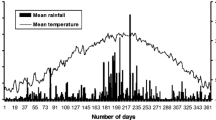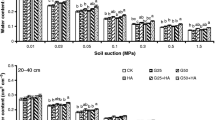Abstract
Purpose
Soil salinization is a major obstacle to the development and utilization of land resources in coastal areas. The purpose of the study is to explore the desalting effect of flue gas desulfurization gypsum (FGDG) on coastal saline-sodic soils by evaluating changes of soil chemical properties (soluble ions, exchangeable cations, and exchangeable sodium percentage (ESP)), plant growth, and heavy metal contents under field conditions.
Materials and methods
A 1-year field experiment was carried out in two typical textures of saline-sodic soils in the east China coastal area. The soil textures were silty loam and clay and five rates of FGDG (0, 15, 30, 45, and 60 Mg·ha−1) were applied to sodic fulvisols (siltic) and spolic technosol (clayic).
Results and discussion
The experiments showed that the chemical properties were effectively improved by FGDG on the topsoil (0–30 cm) of two different texture saline-sodic soils, and desalting effects (ESP < 15%) could be reached within 1 year in different patterns. For sodic fulvisols (siltic), soluble ions, exchangeable cations and ESP linearly changed with FGDG increases, and root length and biomass of Salix integra were increased too. For spolic technosol (clayic), although the chemical indicators and ESP of topsoil could be improved at low FGDG rate, growth of roots was still restricted even at higher FGDG amounts. The experiments also showed that there was no ecological risk of heavy metals for FGDG application.
Conclusions
FGDG is performed as an eco-friendly amendment for the desalination of coastal saline-sodic soil. An appropriate amount of FGDG application needs to consider soil types and properties.







Similar content being viewed by others
References
Bittell JE, Miller RJ (1974) Lead, cadmium, and calcium selectivity coefficients on a montmorillonite, illite, and kaolinite. J Environ Qual 3:250–253
Breker MC (2016) Influence of amendments on chemical and biological properties of sodic soils. North Dakota State University, North Dakota
Briggs CW, Fine R, Markee M, Gustin M (2012) Investigation of the potential for mercury release from flue gas desulfurization solids applied as an agricultural amendment. J Environ Qual 43:253–262
Bezborodov GA, Shadmanov DK, Mirhashimov RT (2010) Mulching and water quality effects on soil salinity and sodicity dynamics and cotton productivity in Central Asia. Agric Ecosyst Environ 138(1/2):95–102
Chen LM, Dick WA (2011) Gypsum as an agricultural amendment: general use guidelines. The Ohio State University, Columbus, Ohio, pp 1–5
Chen LM, Stehouwer R, Tong XG, Kost D, Bighamd JM, Dick WA (2015) Surface coal mine land reclamation using a dry flue gas desulfurization product: short-term and long-term water responses. Chemosphere 134:459–465
Chen LM, Kost D, Tian Y, Guo X, Watts D, Norton D, Wolkowski RP, Dick WA (2014) Effects of gypsum on trace metals in soils and earthworms. J Environ Qual 43(1):263–272
Chi CM, Zhao CW, Sun XJ, Wang ZC (2012) Reclamation of saline-sodic soil properties and improvement of rice growth and yield using desulfurized gypsum in the west of Songnen Plain, northeast China. Geoderma 187–188:24–30
Crocker W (1922) History of the use of agricultural gypsum. Gypsum Industries Association, Chicago, IL
Dick WA, Kost D, Nakano N (2006) A review of agricultural and other land application uses of flue gas desulfurization products. Electric Power Research Institute. Palo Alto, CA
Dick WA, Stehouwer RC, Bigham JM, Wolfe WE, Hao YL, Adraiano D, Beeghly AJ, Haefner RJ (2000) Beneficial uses of flue gas desulfurization by products: examples and case studies of land application. In: Power JF, Dick WA (eds) Land application of agricultural, industrial, and municipal by products. Soil Science Society of America, Madison, WI, pp 505–536
Eduardo FC, Itacir CF, Gabriel B, Fernando JG (2002) Lime and gypsum application on the wheat crop. Sci Agri 59(2):357–364
Elzahabi M, Yong RN (2001) pH influence on sorption characteristics of heavy metal in the vadose zone. Eng Geol 60(1–4):61–68
Echeverría JC, Morera MT, Mazkiarán C, Garrido JJ (1998) Competitive sorption of heavy metal by soils, isotherms and fractional factorial experiments. Environ Pollut 101:275–284
Franzen D (2007) Salinity and sodicity in North Dakota soils. NDSU Extension Service North Dakota State University
Frenkel H, Gerstl Z, Alperovitch N (1989) Exchange-induced dissolution of gypsum and the reclamation of sodic soils. Soil Sci 40:599–611
Hamza MA, Anderson WK (2003) Responses of soil properties and grain yields to deep ripping and gypsum application in a compacted loamy sand soil contrasted with a sandy clay loam soil in Western Australia. Crop Pasture Sci 54(3):273–282
Hao Y, Wu SM, Pan Y, Li Q, Zhou JZ, Xu YB (2016) Characterization and leaching toxicities of mercury in flue gas desulfurization gypsum from coal-fired power plants in China. Fuel 177:157–163
Hossner LR (1996) Dissolution for total elemental analysis. In: Sparks DL et al (eds) Methods of soil analysis, Part 3, Chemical methods. Soil Science Society of America, Madison, WI, USA, pp 49–64
IUSS Working Group WRB (International Union of Soil Science Working Group on World Reference Base) (2015) International soil classification system for naming soils and creating legends for soil maps. p. 192. World Soil Resources Reports No. 106. FAO, Roma IT EU
Li XP, Mao YM, Liu XC (2015) Flue gas desulfurization gypsum application for enhancing the desalination of reclaimed tidal lands. Ecol Eng 82:566–570
Li XP, Mao YM, He K (2017) Application of FGD gypsum in agriculture and environment. Science Press, Beijing, China (in Chinese)
Mao YM, Li XP, Dick WA, Chen LM (2016) Remediation of saline-sodic soil with flue gas desulfurization gypsum in a reclaimed tidal flat of southeast China. J Environ Sci 45(7): 224–230
Mashhady AS, Rowell DL (1978) Soil alkalinity. I. Equilibria and alkalinity development. Eur J Soil Sci 29(1): 65–75
Ministry of Ecology and Environment of the People’s Republic of China (2018) GB 15618–2018 Soil environmental quality. Beijing, China Environmental Publishing Group (in Chinese), Risk control standard for soil contamination of agricultural land
Qadir M, Schubert S, Ghafoor A (2001) Amelioration strategies for sodic soils: a review. Land Degrad Dev 12(4):357–386
Rengasamy P (2006) World salinization with emphasis on Australia. J Exp Bot 57:1017–1023
Research Institute of Forestry, Chinese Academy of Forestry (1999) LY/T 1251–1999, Analysis methods of water soluble salts of forest soil (In Chinese)
Research Institute of Forestry, Chinese Academy of Forestry (1999) LYT 1249–1999. Calculation of soil alkalinity. Beijing, China (in Chinese)
Richards LA (1954) Diagnosis and improvement of saline and alkali soils (Agriculture Handbook 60, 160). United States Salinity Laboratory, Washington, DC
Sparks DL, Page AL, Helmke PA, Loeppert RH, Rhoades JD (1996) Salinity: electrical conductivity and total dissolved solids. p. 417–435. In: Spark DL(eds.) Methods of soil analysis, Part 3 of Chemical methods. Soil Science Society of America, Madison, WI, USA
Sakai Y, Matsumoto S, Sadakata M (2004) Alkali soil reclamation with flue gas desulfurization gypsum in China and assessment of metal content in corn grains. Soil Sediment Contam 13(1):65–80
State Environmental Protection Agency of China (1987) GB 8173–1987. Control standards of pollutants in fly ash for agricultural use (in Chinese)
Stehouwer RC, Sutton P, Fowler RK, Dick WA (1995) Minespoil amendment with dry flue gas desulfurization by-products: element solubility and mobility. J Environ Qual 24(1):165–174
Shahandeh H, Sumner ME (1993) Establishment of vegetation on by-product gypsum materials. J Environ Qual 22(1):57–61
Soil Survey Staff (2014) Keys to soil taxonomy. 12th edition, p. 351. United States Department of Agriculture, Natural Resources Conservation Service, Lincoln
Tong ZJ, Li QS, Zhou YS (2009) Effects of flue gas desulfurization gypsum on heavy metal desorption and residual morphology in tidal flat reclamation soil. J Ecol and Environ 6:2172–2176 (in Chinese)
Tirado-Corbalá R, Slater BK, Dick WA, Bigham J, Muñoz-Muñoz M (2019) Gypsum amendment effects on micromorphology and aggregation in no-till Mollisols and Alfisols from western Ohio. Geoderma Reg, USA, p 16
The Ministry of Agriculture of the People’s Republic of China (2008) NY/T 1615–2008. Determination of exchangeable bases and total exchangeable bases in calcareous soil (in Chinese)
The Ministry of Agriculture of the People’s Republic of China (2006a) NY/T 1121.6–2006a. Soil testing - Part 6: Determination of soil organic matter (in Chinese)
The Ministry of Agriculture of the People’s Republic of China (2006b) NY/T 1121.4–2006b. Soil testing - Part 4: Method for determination of soil bulk density Sector (in Chinese)
Wang JM, Yang PL (2018) Potential flue gas desulfurization gypsum utilization in agriculture: a comprehensive review. Renew Sust Energ Rev 82:1969–1978
Wang JM, Yang PL, Bai ZK (2013) Effect of byproducts of flue gas desulfurization on the soluble salts composition and chemical properties of sodic soils. PLoS ONE 8(8):1–14
Wang JM, Bai ZK, Yang PL (2012) Sodic soil properties and sunflower growth as affected by byproducts of flue gas desulfurization. PLoS ONE 7(12):e52437
Watts DB, Dick WA (2014) Sustainable uses of FGD gypsum in agricultural systems: introduction. J Environ Qual 43(1):246–252
Yang Z, Wang B (2014) Progress in techniques of improvement and utilization of saline-alkali land in China and its future trend. Soil Water Conserv 2:1–11 (in Chinese)
Yang PL, Li X, Tong ZJ, Li QS, He BY, Wang LL (2016) Use of flue gas desulfurization gypsum for leaching Cd and Pb in reclaimed tidal flat soil. Environ Sci Pollut Res 23(8):7840–7848
Yu HL, Yang P, Lin H, Ren S, He X (2014) Effects of sodic soil reclamation using flue gas desulphurization gypsum on soil pore characteristics, bulk density, and saturated hydraulic conductivity. Soil Sci Soc Am J 78:1201–1213
Yu RH, Liu TX, Xu YP, Zhu C, Zhang Q, Qu ZY, Liu XM, Li CY (2010) Analysis of salinization dynamics by remote sensing in Hetao Irrigation District of North China. Agric Water Manag 97(12):1952–1960
Zhao YG, Wang SJ, Li Y, Liu J, ZhuoYQ ZWK, Wang J (2018a) Long-term performance of flue gas desulfurization gypsum in a large-scale application in a saline-alkali wasteland in northwest China. Agric Ecosyst Environ 261:115–124
Zhao YG, Wang SJ, Li Y, Liu J, ZhuoYQ ZWK, Wang J, Chen HX, Wang J (2018b) Extensive reclamation of saline-sodic soils with flue gas desulfurization gypsum on the Songnen Plain, Northeast China. Geoderma 321:52–60
Acknowledgements
We thank Tara Penner, MSc, from Liwen Bianji (Edanz) (www.liwenbianji.cn/), for editing the English text of a draft of this manuscript.
Funding
This research was supported by the National Public Project of Environmental Protection (No. 201109023), National Natural Science Foundation of China (No. 31901207), and “Training Program for Young and Middle-aged Teachers” of Shanghai Vocational College of Agriculture and Forestry (No. A2-0273–20-02).
Author information
Authors and Affiliations
Corresponding author
Ethics declarations
Competing interests
The authors declare no competing interests.
Additional information
Responsible editor: Claudio Colombo
Publisher's Note
Springer Nature remains neutral with regard to jurisdictional claims in published maps and institutional affiliations.
Rights and permissions
Springer Nature or its licensor holds exclusive rights to this article under a publishing agreement with the author(s) or other rightsholder(s); author self-archiving of the accepted manuscript version of this article is solely governed by the terms of such publishing agreement and applicable law.
About this article
Cite this article
Mao, Y., Li, X. Desalting effect of flue gas desulfurization gypsum (FGDG) on coastal saline-sodic soil with different textures. J Soils Sediments 23, 765–776 (2023). https://doi.org/10.1007/s11368-022-03344-3
Received:
Accepted:
Published:
Issue Date:
DOI: https://doi.org/10.1007/s11368-022-03344-3




